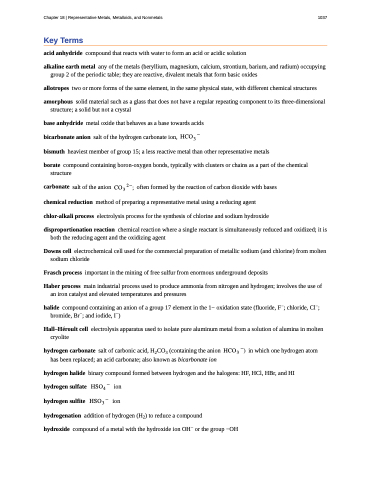Page 1047 - Chemistry--atom first
P. 1047
Chapter 18 | Representative Metals, Metalloids, and Nonmetals 1037
Key Terms
acid anhydride compound that reacts with water to form an acid or acidic solution
alkaline earth metal any of the metals (beryllium, magnesium, calcium, strontium, barium, and radium) occupying
group 2 of the periodic table; they are reactive, divalent metals that form basic oxides
allotropes two or more forms of the same element, in the same physical state, with different chemical structures
amorphous solid material such as a glass that does not have a regular repeating component to its three-dimensional structure; a solid but not a crystal
base anhydride metal oxide that behaves as a base towards acids
bicarbonate anion salt of the hydrogen carbonate ion, ���� �
bismuth heaviest member of group 15; a less reactive metal than other representative metals
borate compound containing boron-oxygen bonds, typically with clusters or chains as a part of the chemical structure
carbonate salt of the anion ��� ��� often formed by the reaction of carbon dioxide with bases
chemical reduction method of preparing a representative metal using a reducing agent
chlor-alkali process electrolysis process for the synthesis of chlorine and sodium hydroxide
disproportionation reaction chemical reaction where a single reactant is simultaneously reduced and oxidized; it is both the reducing agent and the oxidizing agent
Downs cell electrochemical cell used for the commercial preparation of metallic sodium (and chlorine) from molten sodium chloride
Frasch process important in the mining of free sulfur from enormous underground deposits
Haber process main industrial process used to produce ammonia from nitrogen and hydrogen; involves the use of
an iron catalyst and elevated temperatures and pressures
halide compound containing an anion of a group 17 element in the 1− oxidation state (fluoride, F−; chloride, Cl−; bromide, Br−; and iodide, I−)
Hall–Héroult cell electrolysis apparatus used to isolate pure aluminum metal from a solution of alumina in molten cryolite
hydrogen carbonate salt of carbonic acid, H2CO3 (containing the anion ���� �� in which one hydrogen atom has been replaced; an acid carbonate; also known as bicarbonate ion
hydrogen halide binary compound formed between hydrogen and the halogens: HF, HCl, HBr, and HI hydrogen sulfate ���� � ion
hydrogen sulfite ���� � ion
hydrogenation addition of hydrogen (H2) to reduce a compound
hydroxide compound of a metal with the hydroxide ion OH− or the group −OH


